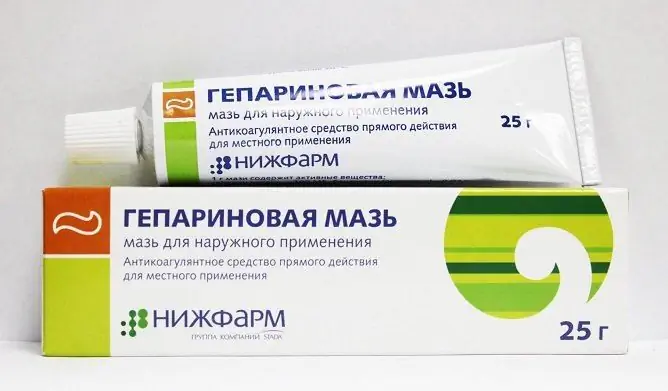- Author Rachel Wainwright [email protected].
- Public 2023-12-15 07:39.
- Last modified 2025-11-02 20:14.
Oftocypro
Oftocipro: instructions for use and reviews
- 1. Release form and composition
- 2. Pharmacological properties
- 3. Indications for use
- 4. Contraindications
- 5. Method of application and dosage
- 6. Side effects
- 7. Overdose
- 8. Special instructions
- 9. Application during pregnancy and lactation
- 10. Use in childhood
- 11. Drug interactions
- 12. Analogs
- 13. Terms and conditions of storage
- 14. Terms of dispensing from pharmacies
- 15. Reviews
- 16. Price in pharmacies
Latin name: Oftocipro
ATX code: S03AA07
Active ingredient: ciprofloxacin (Ciprofloxacin)
Manufacturer: Tatkhimfarmpreparaty, JSC (Russia)
Description and photo updated: 30.11.2018
Prices in pharmacies: from 50 rubles.
Buy

Ophtocypro is an antimicrobial agent.
Release form and composition
Dosage form - eye ointment: white or white with a slightly yellowish, grayish or greenish tint (3 or 5 g each in aluminum tubes, in a cardboard box 1 tube and instructions for use of Oftcipro).
Composition of 1 g of ointment:
- active substance: ciprofloxacin (in the form of hydrochloride) - 3 mg;
- auxiliary components: anhydrous lanolin, medical petroleum jelly, nipagin (methyl parahydroxybenzoate).
Pharmacological properties
Pharmacodynamics
The active ingredient of Ophtocypro is ciprofloxacin, a fluoroquinolone derivative, a broad-spectrum antimicrobial agent.
The mechanism of action of the drug is due to its ability to suppress bacterial DNA gyrase (topoisomerases II and IV, which are responsible for unwinding DNA to ensure further transcription), as well as disrupt DNA synthesis, division and growth of bacteria.
Ciprofloxacin has a bactericidal effect on gram-negative microorganisms during division and rest, and on gram-positive organisms during division.
The drug is active against the following pathogens:
- gram-negative aerobic bacteria: enterobacteria (Hafnia alvei, Citrobacter spp., Edwardsiella tarda, Escherichia coli, Morganella morganii, Enterobacter spp., Shigella spp., Salmonella spp., Providencia spp., Klebsiella spp., Protera marus vulgarus, Yersinia spp., Vibrio spp.), Other gram-negative bacteria (Aeromonas spp., Haemophilus spp., Neisseria spp., Campylobacter jejuni, Moraxella catarrhalis, Plesiomonas shigelloides, Pasteurella multocida, Pseudomonas aeruginas aeruginas);
- gram-positive aerobic bacteria: Streptococcus spp. (Streptococcus agalactiae, Streptococcus pyogenes), Staphylococcus spp. (Staphylococcus hominis, Staphylococcus haemolyticus, Staphylococcus aureus, Staphylococcus saprophyticus);
- some intracellular pathogens: Brucella spp., Corynebacterium diphtheriae, Chlamydia trachomatis, Legionella pneumophila, Listeria monocytogenes, Mycobacterium kansasii, Mycobacterium tuberculosis.
Enterococcus faecalis, Streptococcus pneumoniae and Mycobacterium avium have moderate sensitivity to ciprofloxacin (high concentrations of the drug are required to suppress them).
Most methicillin-resistant staphylococci are also resistant to ciprofloxacin.
The following microorganisms are resistant to the action of ciprofloxacin: Pseudomonas maltophilia, Pseudomonas cepacia, Clostridium difficile, Ureaplasma urealyticum, Bacteroides fragilis, Nocardia asteroides.
Ophtocypro is ineffective in diseases caused by Treponema pallidum.
Resistance to the drug develops very slowly, since after its action there are almost no persistent microorganisms left. In addition, bacterial cells do not possess enzymes that inactivate ciprofloxacin.
Pharmacokinetics
Ciprofloxacin is characterized by low systemic absorption when applied topically.
Indications for use
Ophtocypro eye ointment is intended for the treatment of the following infectious and inflammatory eye diseases caused by sensitive microorganisms: keratitis, keratoconjunctivitis, meibomitis, blepharitis, acute and subacute conjunctivitis, blepharoconjunctivitis, chronic dacryocystitis, bacterial or corneal ulcers.
For prophylactic purposes, Ophtocipro is used to prevent infectious complications before and after surgical interventions in ophthalmic surgery.
Contraindications
Absolute:
- viral and fungal eye infections;
- age up to 2 years;
- period of pregnancy and lactation;
- hypersensitivity to any component of the drug.
Ophtocipro eye ointment should be used with caution in the following cases:
- convulsive syndrome;
- disorders of cerebral circulation;
- atherosclerosis of the vessels of the brain.
Oftocipro, instructions for use: method and dosage
Ophtocipro is intended for conjunctival use: an ointment with a strip 1-1.5 cm long should be applied behind the lower eyelid of the affected eye 3 times a day for 2 days, in the next 5 days the frequency of application is reduced to 2 times a day.
In case of a severe course of the infectious process, you can lay an ointment every 3-4 hours at the beginning of treatment and then increase the intervals between the use of the drug as inflammation decreases.
The maximum duration of therapy is 14 days.
Ointment application rules:
- Gently pull the lower eyelid down.
- Pressing lightly on the tube, insert a strip of ointment into the conjunctival sac.
- Slowly release the eyelid and press it with a cotton swab or cotton swab for 1-2 minutes.
- Close your eyes for 1-2 minutes.
Side effects
Immediately after application of the ointment, slight soreness, burning, itching and conjunctival hyperemia may occur. In case of intolerance to any component of Ophtocypro, allergic reactions are possible.
In rare cases, the following side effects are observed: sensation of a foreign body in the eye, lacrimation, photophobia, eyelid edema, decreased visual acuity, corneal infiltration, keratitis, keratopathy, an unpleasant taste in the mouth immediately after the ointment is applied, nausea, the development of superinfection; in patients with corneal ulcers, the appearance of a white crystalline precipitate.
Overdose
There have been no reports of overdose cases of Oftocipro.
If the ointment is accidentally taken inside, there are no specific signs, the following symptoms may develop: nausea, diarrhea, vomiting, anxiety, headache, fainting. As a therapeutic measure, it is recommended to ensure a sufficient flow of fluid into the body, in order to avoid crystalluria - the creation of an acidic reaction of urine. Treatment is symptomatic.
special instructions
It is not recommended to use contact lenses during the period of Ophtocipro application.
In the case of the simultaneous appointment of other ophthalmic agents, at least 5-minute intervals between their injections should be observed.
Influence on the ability to drive vehicles and complex mechanisms
Immediately after the application of the ointment, the clarity of visual perception may be impaired. In this regard, within 15 minutes after using the drug, it is recommended to refrain from performing potentially dangerous types of work and driving a car.
Application during pregnancy and lactation
Ophtocypro is contraindicated in pregnant and breastfeeding women.
Pediatric use
Ophtocypro is not used to treat children under 2 years of age.
Drug interactions
With the simultaneous use of other drugs, drug interactions have not been identified.
There is evidence that the systemic effect of some quinolones can lead to an increase in the plasma concentration of theophylline, affect the metabolism of caffeine, and enhance the effect of oral anticoagulants (including warfarin and its derivatives). A temporary increase in serum creatinine has been reported in patients receiving cyclosporine concurrently with systemic ciprofloxacin.
Analogs
Ophtocypro analogs are: Vigamox, Dancil, Zimar, L-Optic Rompharm, Lofox, Maxiflox, Moxifur, Ofloxacin, Oftaquix, Signicef, Uniflox, Floxal, Tsiprolet, Tsipromed, Ciprofloxacin and others.
Terms and conditions of storage
Store at a temperature of 2-25 ° C out of reach of children.
Shelf life is 2 years.
Terms of dispensing from pharmacies
Dispensed by prescription.
Reviews about Oftocipro
Reviews about Ophtocipro are mostly positive: the drug is good for ophthalmic diseases caused by sensitive microorganisms.
The disadvantages of certain patients include a too oily consistency of the ointment and an inconvenient tube to use. There are isolated reviews about the lack of effect after the course of treatment.
Price for Oftotsipro in pharmacies
The approximate price of Oftotsipro for a 3 g tube of ointment is 138-212 rubles.
Oftocipro: prices in online pharmacies
|
Drug name Price Pharmacy |
|
Ophtocypro 0.3% ophthalmic ointment 3 g 1 pc. RUB 50 Buy |
|
Ophtocypro eye ointment 0.3% 3g 136 RUB Buy |

Maria Kulkes Medical journalist About the author
Education: First Moscow State Medical University named after I. M. Sechenov, specialty "General Medicine".
Information about the drug is generalized, provided for informational purposes only and does not replace the official instructions. Self-medication is hazardous to health!






